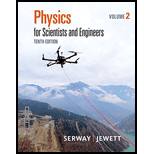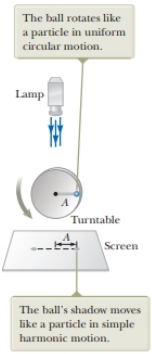
Concept explainers
The ball in Figure 15.13 moves in a circle of radius 0.50 m. At t = 0, the ball is located on the left side of the turntable, exactly opposite its position in Figure 15.13. What are the correct values for the amplitude and phase constant (relative to an x axis to the right) of the
Figure 15.13 An experimental setup for demonstrating the connection between a particle in simple harmonic motion and a corresponding particle in uniform circular motion.

Trending nowThis is a popular solution!

Chapter 15 Solutions
Physics for Scientists and Engineers, Volume 2
Additional Science Textbook Solutions
College Physics (10th Edition)
College Physics
Physics for Scientists and Engineers: A Strategic Approach with Modern Physics (4th Edition)
Conceptual Physical Science Explorations
Conceptual Physics (12th Edition)
- The total energy of a simple harmonic oscillator with amplitude 3.00 cm is 0.500 J. a. What is the kinetic energy of the system when the position of the oscillator is 0.750 cm? b. What is the potential energy of the system at this position? c. What is the position for which the potential energy of the system is equal to its kinetic energy? d. For a simple harmonic oscillator, what, if any, are the positions for which the kinetic energy of the system exceeds the maximum potential energy of the system? Explain your answer. FIGURE P16.73arrow_forwardA simple harmonic oscillator has amplitude A and period T. Find the minimum time required for its position to change from x = A to x = A/2 in terms of the period T.arrow_forwardC, N A uniform plank of length L and mass M is balanced on a fixed, semicircular bowl of radius R (Fig. P16.19). If the plank is tilted slightly from its equilibrium position and released, will it execute simple harmonic motion? If so, obtain the period of its oscillation.arrow_forward
- For each expression, identify the angular frequency , period T, initial phase and amplitude ymax of the oscillation. All values are in SI units. a. y(t) = 0.75 cos (14.5t) b. vy (t) = 0.75 sin (14.5t + /2) c. ay (t) = 14.5 cos (0.75t + /2) 16.3arrow_forwardA spherical bob of mass m and radius R is suspended from a fixed point by a rigid rod of negligible mass whose length from the point of support to the center of the bob is L (Fig. P16.75). Find the period of small oscillation. N The frequency of a physical pendulum comprising a nonuniform rod of mass 1.25 kg pivoted at one end is observed to be 0.667 Hz. The center of mass of the rod is 40.0 cm below the pivot point. What is the rotational inertia of the pendulum around its pivot point?arrow_forwardWhich of the following statements is not true regarding a massspring system that moves with simple harmonic motion in the absence of friction? (a) The total energy of the system remains constant. (b) The energy of the system is continually transformed between kinetic and potential energy. (c) The total energy of the system is proportional to the square of the amplitude. (d) The potential energy stored in the system is greatest when the mass passes through the equilibrium position. (e) The velocity of the oscillating mass has its maximum value when the mass passes through the equilibrium position.arrow_forward
- The expression x = 8.50 cos (2.40 t + /2) describes the position of an object as a function of time, with x in centimeters and t in seconds. What are the a. frequency, b. period, c. amplitude, and d. initial phase of the objects motion? e. What is the position of the particle at t = 1.45 s?arrow_forwardConsider the simplified single-piston engine in Figure CQ12.13. Assuming the wheel rotates with constant angular speed, explain why the piston rod oscillates in simple harmonic motion. Figure CQ12.13arrow_forwardA uniform annular ring of mass m and inner and outer radii a and b, respectively, is pivoted around an axis perpendicular to the plane of the ring at point P (Fig. P16.35). Determine its period of oscillation. FIGURE P16.35arrow_forward
- An automobile with a mass of 1000 kg, including passengers, settles 1.0 cm closer to the road for every additional 100 kg of passengers. It is driven with a constant horizontal component of speed 20 km/h over a washboard road with sinusoidal bumps. The amplitude and wavelength of the sine curve are 5.0 cm and 20 cm, respectively. The distance between the front and back wheels is 2.4 m. Find the amplitude of oscillation of the automobile, assuming it moves vertically as an undamped driven harmonic oscillator. Neglect the mass of the wheels and springs and assume that the wheels are always in contact with the road.arrow_forwardA block of mass m rests on a frictionless, horizontal surface and is attached to two springs with spring constants k1 and k2 (Fig. P16.22). It is displaced to the right and released. Find an expression for the angular frequency of oscillation of the resulting simple harmonic motion. FIGURE P16.22 Problems 22 and 81.arrow_forwardFigure 12.4 shows two curves representing particles undergoing simple harmonic motion. The correct description of these two motions is that the simple harmonic motion of particle B is (a) of larger angular frequency and larger amplitude than that of particle A, (b) of larger angular frequency and smaller amplitude than that of particle A, (c) of smaller angular frequency and larger amplitude than that of particle A, or (d) of smaller angular frequency and smaller amplitude than that of particle A. Figure 12.4 (Quick Quiz 12.3) Two xt graphs for particles undergoing simple harmonic motion. The amplitudes and frequencies are different for the two particles.arrow_forward
 Physics for Scientists and Engineers: Foundations...PhysicsISBN:9781133939146Author:Katz, Debora M.Publisher:Cengage Learning
Physics for Scientists and Engineers: Foundations...PhysicsISBN:9781133939146Author:Katz, Debora M.Publisher:Cengage Learning Principles of Physics: A Calculus-Based TextPhysicsISBN:9781133104261Author:Raymond A. Serway, John W. JewettPublisher:Cengage Learning
Principles of Physics: A Calculus-Based TextPhysicsISBN:9781133104261Author:Raymond A. Serway, John W. JewettPublisher:Cengage Learning Classical Dynamics of Particles and SystemsPhysicsISBN:9780534408961Author:Stephen T. Thornton, Jerry B. MarionPublisher:Cengage Learning
Classical Dynamics of Particles and SystemsPhysicsISBN:9780534408961Author:Stephen T. Thornton, Jerry B. MarionPublisher:Cengage Learning College PhysicsPhysicsISBN:9781305952300Author:Raymond A. Serway, Chris VuillePublisher:Cengage Learning
College PhysicsPhysicsISBN:9781305952300Author:Raymond A. Serway, Chris VuillePublisher:Cengage Learning Physics for Scientists and Engineers, Technology ...PhysicsISBN:9781305116399Author:Raymond A. Serway, John W. JewettPublisher:Cengage Learning
Physics for Scientists and Engineers, Technology ...PhysicsISBN:9781305116399Author:Raymond A. Serway, John W. JewettPublisher:Cengage Learning College PhysicsPhysicsISBN:9781938168000Author:Paul Peter Urone, Roger HinrichsPublisher:OpenStax College
College PhysicsPhysicsISBN:9781938168000Author:Paul Peter Urone, Roger HinrichsPublisher:OpenStax College





